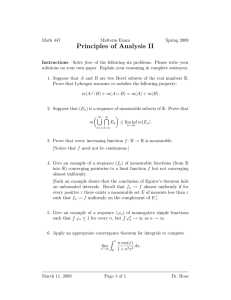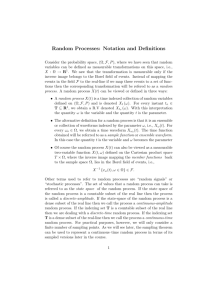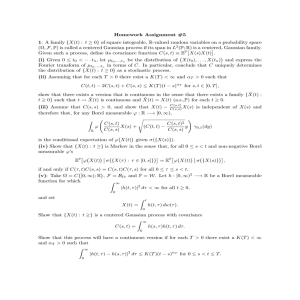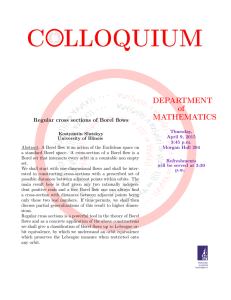SOLUTIONS OF HW5 March 11, 2011
advertisement
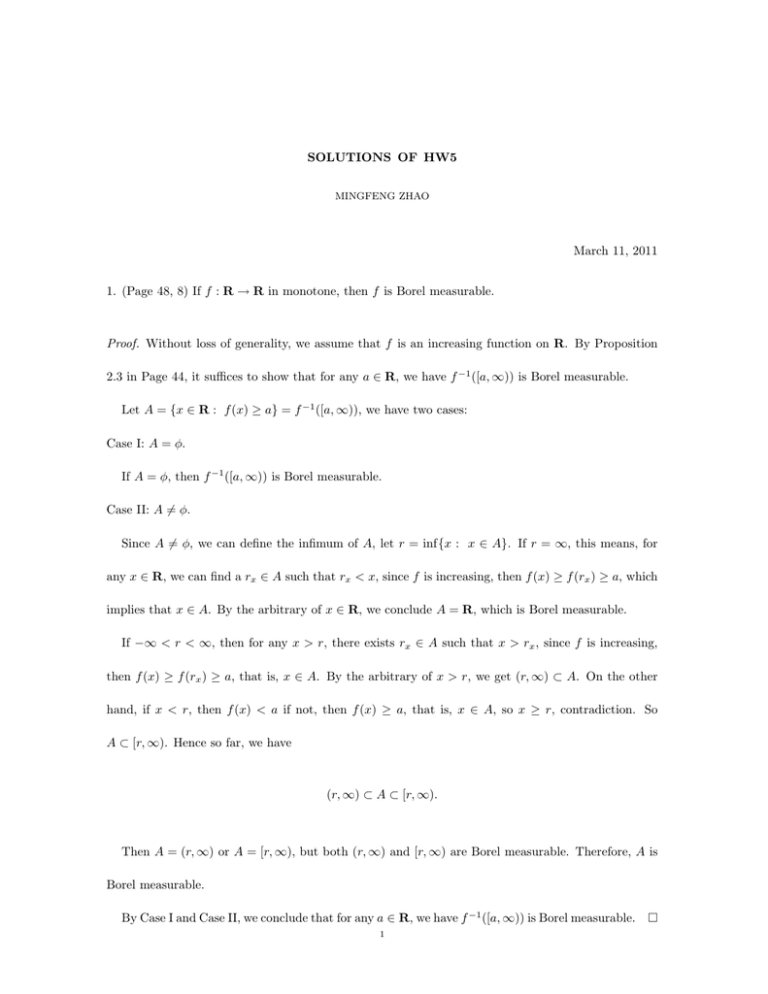
SOLUTIONS OF HW5
MINGFENG ZHAO
March 11, 2011
1. (Page 48, 8) If f : R → R in monotone, then f is Borel measurable.
Proof. Without loss of generality, we assume that f is an increasing function on R. By Proposition
2.3 in Page 44, it suffices to show that for any a ∈ R, we have f −1 ([a, ∞)) is Borel measurable.
Let A = {x ∈ R : f (x) ≥ a} = f −1 ([a, ∞)), we have two cases:
Case I: A = φ.
If A = φ, then f −1 ([a, ∞)) is Borel measurable.
Case II: A 6= φ.
Since A 6= φ, we can define the infimum of A, let r = inf{x : x ∈ A}. If r = ∞, this means, for
any x ∈ R, we can find a rx ∈ A such that rx < x, since f is increasing, then f (x) ≥ f (rx ) ≥ a, which
implies that x ∈ A. By the arbitrary of x ∈ R, we conclude A = R, which is Borel measurable.
If −∞ < r < ∞, then for any x > r, there exists rx ∈ A such that x > rx , since f is increasing,
then f (x) ≥ f (rx ) ≥ a, that is, x ∈ A. By the arbitrary of x > r, we get (r, ∞) ⊂ A. On the other
hand, if x < r, then f (x) < a if not, then f (x) ≥ a, that is, x ∈ A, so x ≥ r, contradiction. So
A ⊂ [r, ∞). Hence so far, we have
(r, ∞) ⊂ A ⊂ [r, ∞).
Then A = (r, ∞) or A = [r, ∞), but both (r, ∞) and [r, ∞) are Borel measurable. Therefore, A is
Borel measurable.
By Case I and Case II, we conclude that for any a ∈ R, we have f −1 ([a, ∞)) is Borel measurable. 1
2
MINGFENG ZHAO
2. (Page 49, 11) Suppose that f is a function on R × Rk such that f (x, ·) is Borel measurable for
each x ∈ R, and f (·, y) is continuous for each y ∈ Rk . For any n ∈ N, define fn as follows: For any
i ∈ Z, let ai =
i
n,
and for ai ≤ x < ai+1 , let
fn (x, y) =
f (ai+1 , y)(x − ai ) − f (ai , y)(x − ai+1 )
.
ai+1 − ai
Then fn is Borel measurable on R × Rk for all n ≥ 1, and fn −→ f pointwise, as n → ∞; hence f
is Borel measurable on R × Rk . Conclude by induction that every function on Rn that is continuous
in each variable separately is Borel measurable.
Proof. (i). For any n ∈ N, and x ∈ R, we know that for each there exists a unique i ∈ Z such that
i ≤ nx < i + 1. In fact i = [nx], where [z] is the integer part of z ∈ Z. So we have ai =
ai+1 =
i
n
=
i
n
=
[nx]
n
,and
[nx]+1
.
n
For i ∈ Z, we let Ei = [ai , ai+1 ], then Ei is Borel measurable on R × Rk , which implies that 1Ei is
Borel measurable on R × Rk . Then we get
fn (x, y)
=
X f (ai+1 , y)(x − ai ) − f (ai , y)(x − ai+1 )
ai+1 − ai
i∈Z
=
X
· 1Ei (x)
n(f (ai+1 , y)(x − ai ) − f (ai , y)(x − ai+1 )) · 1Ei (x)
i∈Z
And for all (x, y) ∈ R × Rk , the series
X
n(f (ai+1 , y)(x − ai ) − f (ai , y)(x − ai+1 )) · 1Ei0 (x)
i∈Z
=
n(f (ai0 +1 , y)(x − ai0 ) − f (ai0 , y)(x − ai0 +1 ))
Which implies that
P
i∈Z
for some i0 = [nx] ∈ Z
n(f (ai+1 , y)(x − ai ) − f (ai , y)(x − ai+1 )) · 1Ei0 (x) converges for all (x, y) ∈
R × Rk .
Consider the function gi (x, y) = n(f (ai+1 , y)(x − ai ) − f (ai , y)(x − ai+1 )) · 1Ei0 (x) for any i ∈ Z.
Since f (ai+1 , y), x − ai , f (ai , y), x − ai+1 , 1Ei (x) are Borel measurable on R × Rk , by Proposition 2.6
in Page 45, we know that gi (x, y) is Borel measurable on R × Rk . So By proposition 2.6 in Page 45
SOLUTIONS OF HW5
again, we get
P
|i|≤N
3
gi (x, y) is Borel measurable on R × Rk for all N ≥ 1. On the other hand, we
know
fn (x, y) =
X
X
gi (x, y) = lim
N →∞
i∈Z
gi (x, y).
|i|≤N
By Proposition 2.7 in Page 45, we conclude that fn (x, y) is Borel measurable on R × Rk .
(ii). For any (x, y) ∈ R × Rk , and fix. Then for each n ∈ Z, we have ai =
[nx]
n ,
and ai+1 =
[nx]+1
,
n
hence we know that
fn (x, y) − f (x, y)
=
f (ai+1 , y)(x − ai ) − f (ai , y)(x − ai+1 )
− f (x, y)
ai+1 − ai
= n(f (ai+1 , y)(x − ai ) − f (ai , y)(x − ai+1 )) − f (x, y)
= f (ai+1 , y)(nx − nai ) − f (ai , y)(nx − nai+1 ) − f (x, y)
=
(f (ai+1 , y) − f (x, y))(nx − nai ) + (f (x, y) − f (ai , y))(nx − nai+1 )
+f (x, y)(nx − nai ) − f (x, y)(nx − nai+1 ) − f (x, y)
=
(f (ai+1 , y) − f (x, y))(nx − nai ) + (f (x, y) − f (ai , y))(nx − nai+1 ) + f (x, y)(nai+1 − nai ) − f (x, y)
=
(f (ai+1 , y) − f (x, y))(nx − nai ) + (f (x, y) − f (ai , y))(nx − nai+1 )
=
[nx] + 1
[nx]
f
, y − f (x, y) · (nx − [nx] − 1) + f (x, y) − f
,y
· (nx − [nx])
n
n
Since nai+1 − nai = n(ai+1 − ai ) = 1
But we know that [nx] ≤ nx < [nx] + 1, which tells us that |nx − [nx]| < 1, and |nx − [nx] − x| < 2,
and
[nx]
n
≤x<
[nx]+1
.
n
Hence
lim
n→∞
[nx]
[nx] + 1
= lim
= x.
n→∞
n
n
Since f (·, y) is continuous, then limn→∞ f
Therefore, we get
lim fn (x, y) − f (x, y)
n→∞
[nx]
n ,y
= f (x, y), and limn→∞ f
[nx]+1
,y
n
= f (x, y)
4
MINGFENG ZHAO
[nx] + 1
[nx]
= lim
f
, y − f (x, y) · (nx − [nx] − 1) + f (x, y) − f
,y
· (nx − [nx])
n→∞
n
n
=
0.
Hence fn (x, y) −→ f (x, y), as n → ∞ for all (x, y) ∈ R × Rk . By the result of the part (i), and
Proposition 2.7 in Page 45, we conclude that f is Borel measurable on R × Rk .
(iii). Case I: When n = 2, since f (x1 , ·) is continuous for each x1 ∈ R, hence f (x1 , ·) is Borel
measurable on R. And f (·, x2 ) is continuous for each x2 ∈ R, by the result of (iii), we know f is Borel
measurable on R2 .
Case II: When n = 3, for any x3 ∈ Rn , since f (·, x2 , x3 ) is continuous for each x2 ∈ R, hence
f (·, x2 , x3 ) is Borel measurable on R. Since for each x1 ∈ R, we know f (x1 , ·, x3 ) is continuous, then
by the result of (ii), we get f (·, ·, x3 ) is Borel measurable on R2 . Since f (x1 , x2 , ·) is continuous on
R, by the result of (ii), we get f is Borel measurable on R3 .
By induction, we conclude that the function f : Rn −→ R, and f is continuous in each variable.
then f is Borel measurable.
Department of Mathematics, University of Connecticut, 196 Auditorium Road, Unit 3009, Storrs, CT
06269-3009
E-mail address: mingfeng.zhao@uconn.edu

